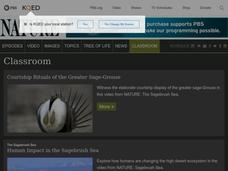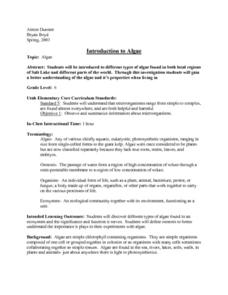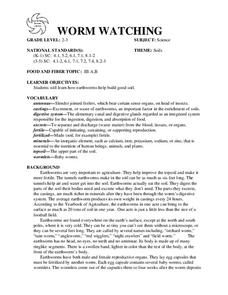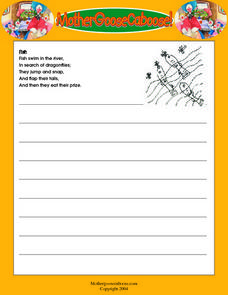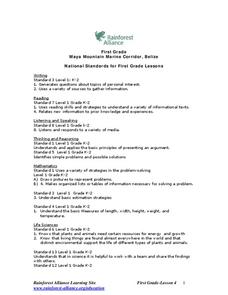Curated OER
What Is El Niño?
Students access information at remote sites using telecommunications, identify impacts by reviewing past El Ni??o events, make and use scale drawings, maps, and maps symbols to find locations and describe relationships.
Curated OER
Reading Comprehension: Fiction and Nonfiction
This resource is made up of a series of reading passages with accompanying questions. On the first page, learners read the definitions of both fiction and non-fiction. They examine four short selections before writing either fiction or...
Curated OER
St. Patrick's Day and Leprechauns
Young learners are introduced to the history, and customs surrounding St. Patrick's Day. This colorful and enchanting lesson has the students hunt for leprechauns, four-leaf clovers, and that lucky pot 'o gold.
Curated OER
Microbes and Health
Students participate in activities that show them how tiny germs are spread. In this germs lesson plan, students engage in hands on lessons to show them how microorganisms can easily spread disease through the mouth and hands.
Curated OER
Waterdrops
In this science worksheet, students investigate the subject of ground water. Students read a story and articles and complete 8 pages of games and activities such as making their own sinkhole, matching, fill in the blank story and a...
Curated OER
Waves Interference
Students identify different wave types and their characteristics. In this wave lesson plan students complete activities by activating tuning forks and interpreting data.
Curated OER
Dunking Duckies - Endless Expansion And Contraction
Students use inquiry to explore how their dunking duckie bobs up and down. In this states of matter lesson, the teacher guides the class towards discovering how the dunking duckies continue to bob up and down for days without being touched.
Curated OER
Imagine a Kelp Forest
Students write a story based on their research of the kelp forest. In this ecosystem lesson plan, students view a video and research the kelp forest ecosystem. They write a short story imagining the discovery of a new species in the kelp...
Curated OER
Touch
Students discover how sense of touch helps us explore our world by feeling it and learning the size, texture and shape of things.
Curated OER
Characteristics of Snakes and Turtles
Students examine the characteristics of snakes and turtles and compare/contrast reptiles with mammals. They watch a video, answer discussion questions, complete information charts, conduct Internet research, and create a habitat diorama.
Curated OER
Introduction to Algae
Students explore different types of algae found in both local regions of Salt Lake and different parts of the world. They discover different types of algae found in an ecosystem and the significance and function it serves.
Curated OER
WORM WATCHING
Students investigate how earthworms help build good soil. They examine the worms carefully to find the ringlike segments and swollen band at the front of the earthworm's body. Students take turns dampening the soil every day and adding...
Curated OER
Animal Poetry -- Printing Practice
In this printing practice worksheet, students read a poem about a particular animal. Students copy the poem on the lines provided. Advanced cursive students could copy this using cursive handwriting. There are 13 poem worksheets available.
Curated OER
A Troublesome Portage
In this portage worksheet, students read a 1 page article on a troublesome portage, find the 5 words listed in the paragraph indicated, label each words part of speech and then define each word. Students imagine they are one of the men...
Curated OER
The Magic School Bus Spins a Web
Students learn along with Ms. Frizzle's class. For this Magic School Bus lesson plan, students explore the world of spiders as they travel into a science fiction film to learn the truth about spiders.
Curated OER
Making a Rainstick
Students construct a rainstick. In this music instructional activity, students investigate the history of the rainstick by reading the book Bringing the Rain to the Kapiti Plain by Verna Aardema. Students express their feelings about the...
Curated OER
Naked to the Eye
Students understand that microorganisms are too small to see but there are other indications they exist. In this microorganisms instructional activity, students recognize that some microorganism are helpful and some are not. Students use...
Curated OER
Who Takes Care of the Maya Forest Corridor?
First graders study the animals in the Maya Forest Reserve. In this conservation lesson, 1st graders create a graph to compare the environment of animals to their own. They design a 3D model of these two environments.
Curated OER
World Habitat Day
In this World Habitat Day lesson plan, students complete activities such as reading a passage, matching phrases, fill in the blanks, choose the correct word, multiple choice, unscramble the words, sequencing, unscramble the sentences,...
Curated OER
Predicting the Growth of Microorganisms
Learners determine where microorganisms might be found around their school. For this scientific investigation lesson, students collect cultures from various locations and place these in petri dishes. They incubate the cultures to see if...
Curated OER
Math and the Greek-Golden Proportions
Fourth graders study math and the golden mean. In this math meets Greek history lesson, 4th graders study ratios and proportions in relation to the Greeks. The use of clay is incorporated ino this lesson.
Curated OER
Hand Washing: I can handle it!
Sixth graders examine microorganisms. In this germs instructional activity, 6th graders observe and record data on the positive and negative aspects of microorganisms. Students complete activities, view a film, and explore...
Curated OER
Gas Laws and Alka-Seltzer Rockets
Students investigate the Ideal Gas Law. For this three states of matter lesson, students create Alka-Seltzer rockets using film canisters. Students record observations and data according to the scientific method and explain the gas...
Curated OER
Coloring Fabrics With Dyes from Plant Materials K-12 Experiments & Background Information
Students investigate the effects of acid and bases on dyes made with plant materials. For this chromatography lesson students predict color outcomes and complete a lab activity on color combinations.











